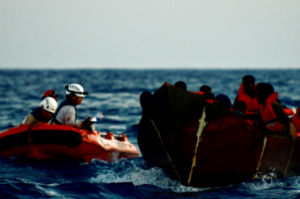By Mediterranea Saving Humans
The war unleashed by the Italian Government against people on the move and solidarity was heralded as a triumphant “Ride of the Valkyries”. In three months it has now turned into a grueling chess game, with moves and countermoves taking place between the refinement of the border regime’s brutalisation strategies, and the solidarity practices of resistance and counter-offensives against the authorities.
The starting point is the abysmal distance between the bombastic words of electoral propaganda and the actual reality in the Central Mediterranean. The slogans of the far-right parties now in government in Italy were, again, “closed ports” and, even harsher, “naval blockade.”
The reality is instead, for the year 2022 according to official data from the Ministry of the Interior, 105,461 people landed in Italy. Of these, 11,892 were rescued by civil fleet vessels (about 11 percent of the total), while the remaining 89 percent of these landings were either autonomous arrivals or rescues carried out by the Italian Coast Guard and, to a lesser extent, the patrol boats of the Guardia di Finanza (a financial police force that also carries out border control duties for the Italian state). In the first twelve days of January 2023, about 3,800 people landed – and of these only 110 were rescued by the Civil fleet.
Between the end of October and the beginning of November, the Meloni Government’s first move was the attempt to prevent the non-governmental ships Rise Above, Ocean Viking, Geo Barents and Humanity1 from entering Italian territorial waters. This route proved impracticable, due to the absence of valid reasons for the ban and the obvious violation of international law.
And so, there was a first change of strategy with the invention of the inhuman practice of “selective disembarkation”: ships could enter the port of Catania, but only for the time strictly necessary to disembark the people considered “vulnerable subjects”, while any others would be sent back to the high seas without a precise destination. In this case, the determination of the people on board, the resolve of the ship’s crews and captains and the refusal of the doctors in charge to submit to the cruel political diktats of the authorities, together with a prompt and widespread mobilisation of Italian civil society and European public opinion, dismantled the government’s strategy: after ten days of tug-of-war, all people were allowed to disembark and the line of discriminatory “selective disembarkation” was defeated on its first attempt.
At the same time the Italian government attempted to bully the people on the move, forcing them into long standoffs in order to put pressure on other EU member states, in particular the flag states of the non-governmental ships involved, to increase relocation numbers. With the arrival of the Ocean Viking in Toulon, the only result achieved by the Italian government, beyond the usual rhetorical commitments of the European Commission, was to provoke a serious diplomatic incident with France. A political disaster across the board.
Last December this forced a further change of strategy, based on two pillars. The first in continuity with the Italian and European policies of border externalisation over the last seven years. The second with some novelties.
Let us start with the latter, which has resulted in a new approach by the Italian authorities and in the approval on January 2nd 2023 of the Decree Law “Urgent provisions for the management of migratory flows”, better known as the “Piantedosi Decree” (named after the responsible Minister of the Interior). In essence, this decree provides for new administrative punishment measures against civil rescue vessels which do not meet the following standards:
- be certified from a technical-nautical point of view and authorised by the flag state to carry out search and rescue activities at sea “in a systematic manner”;
- “inform” survivors on board about the possibility of requesting international protection and collect personal data useful to the authorities;
- head immediately and “without delay” after a single rescue operation towards the port of disembarkation assigned by the authorities.
In the event of a first violation, an initial fine of between €10,000 and €50,000 for the ship’s captain and owner and the administrative detention of the ship for two months shall be applied as a penalty. In the event of subsequent violations, further fines and above all seizure and indefinite confiscation of the vessel apply. The application of these measures has been removed from the ordinary third-party judge and entrusted to the discretionary powers of the ministry of the interior and its peripheral structures, the prefectures.

Publication Mediterranea Saving Humans (Twitter @RescueMed)
The constitutional and international law legitimacy of these rules is currently under scrutiny. But even from a first cursory reading of the decree, it is clear that the government’s declared and explicit goal is to hinder the activity of the civil fleet’s rescue vessels in every possible way. Indeed, it is not difficult to imagine a new offensive on the issue of “technical certifications”. Exactly as the insistence on heading “without delay” to the assigned port is intended to prevent the same ship from carrying out several rescue operations.
In fact, it is not by chance that the approval of the decree was anticipated and followed by an unprecedented practice from the Viminale and Italian Maritime Rescue Coordination Centre (IT MRCC in Rome): after years in which they tried to shirk as much as possible of the coordination responsibility and there were long delays in assigning the port of disembarkation, now the port is indicated immediately and it is always a port very far from the rescue area – 1.500 km and four or five days of navigation – along the coasts of central and northern Italy in the Tyrrhenian or Adriatic Sea, for example Livorno, Ancona or Ravenna.
The objective is clear: not only to increase the costs of running civil missions at sea, but to keep civil fleet ships as far away from the Central Mediterranean as possible. In particular to keep them away from the SAR region allocated from 2018 to Libya. The risk here is twofold: fewer ships in the area of operation means the danger of more deaths at sea, and above all makes free space for the interception, capture and deportation of people on the move by the militias of the so-called Libyan and Tunisian Coast Guard.
The second pillar of the strategy is in fact a grand re-launch of cooperation for pull- and push-backs at sea and the detention of migrants in camps on shore. On 29th December, a summit meeting took place in Tripoli between the Italian (chief of police and foreign intelligence) and Libyan (including some notorious war criminals) security apparatuses. On 2nd January, the Italian secret services were in Benghazi to meet the militias in Cyrenaica and organise the “prevention of departures” along the route from there. In the coming days, the minister of foreign affairs, Tajani, and of the interior, Piantedosi, will also be in Turkey, Tunisia, and again in Libya precisely to strengthen cooperation with those regimes on border control.
Instead of opening legal and safe passages of entry into Europe, the Italian government has opened a new/old chapter in the vicious war against the freedom of movement of people and solidarity. But as the conflict at the port of Catania has shown, as with the struggles of irreducible migrants at sea (as well as of refugees in Tripoli and Geneva), the continued growth of solidarity mobilisations, the continued presence of the civil fleet, the development of monitoring and witness work, and of denunciation and litigation work, what all this has shown, is that no government strategy is unassailable. And, despite the ever-high prices being paid in terms of unnecessary suffering and death, that no government strategy is ultimately invincible.
January 12, 2023



